Christopher Allen's Blog, page 10
December 11, 2015
Signage Gone Wrong
Yeah, I'm kind of a boring tourist. Something wild and crazy could be happening to the left or to the right, but I'm taking a picture of a sign because "its" (possessive) is spelled with an apostrophe. When it all comes down to it, there are aspects of life that are much more important, so this is just a bit of fun for my editor friends out there. Disclaimer: I have the highest respect for my fellow Earthlings; in fact, my cup of brotherly love is sloshing over its (possessive: no apostrophe!) brim. I'm sure if I were required to create a sign in, say, Thai or Hindi, I'd probably make some hilarious mistakes; they'd probably even be adorable. I'd also buy a native speaker a beer and get my sign corrected.
 As a teacher of English as a second language, I know this one is hard. Non-native speakers don't always hear the difference between of and off. I like this one a lot. It takes the bossy imperative "Take off your shoes" and transforms it into a nicer, friendlier "Take of your shoes" as if my shoes are in that pot and I can take as much of them as I want. I like that. Thank you, Koh Samui, for being so generous with my shoes.
As a teacher of English as a second language, I know this one is hard. Non-native speakers don't always hear the difference between of and off. I like this one a lot. It takes the bossy imperative "Take off your shoes" and transforms it into a nicer, friendlier "Take of your shoes" as if my shoes are in that pot and I can take as much of them as I want. I like that. Thank you, Koh Samui, for being so generous with my shoes.
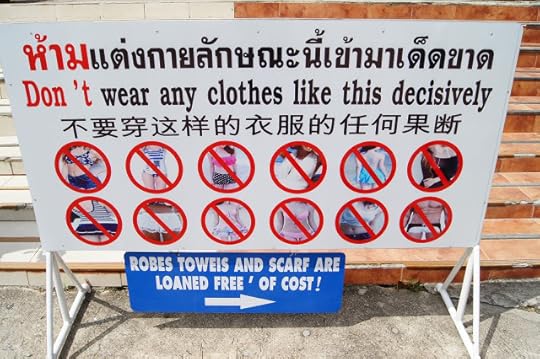 But what if I want to wear a bikini or a halter top tentatively, which would most definitely be the case? Or demurely? I'd like to think of myself as a demure clothes wearer. Don't get me started on that blue sign. What the hell is a towei? And forget the Oxford comma. What about commas at all? And do they have only one scarf? Ick: bacteria farm. On another subject, this sign borders on soft porn. I can imagine old guys staring at it for days.
But what if I want to wear a bikini or a halter top tentatively, which would most definitely be the case? Or demurely? I'd like to think of myself as a demure clothes wearer. Don't get me started on that blue sign. What the hell is a towei? And forget the Oxford comma. What about commas at all? And do they have only one scarf? Ick: bacteria farm. On another subject, this sign borders on soft porn. I can imagine old guys staring at it for days.
 I'd like to take the lone apostrophe in the sign above this one and insert it here. This sign is, as the sign says, from the city of Kandy in Sri Lanka, and the city is relatively free of litter.
I'd like to take the lone apostrophe in the sign above this one and insert it here. This sign is, as the sign says, from the city of Kandy in Sri Lanka, and the city is relatively free of litter.
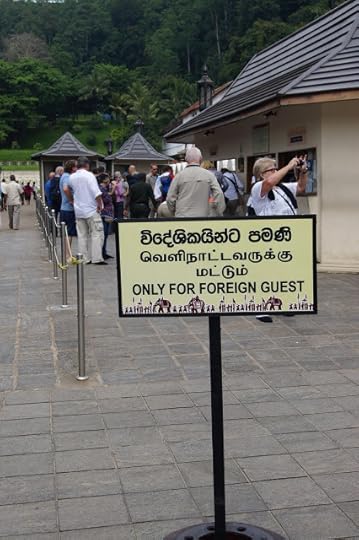 OK, there is generally a problem when it comes to plurals--I get that. This sign is also from the world heritage city of Kandy, Sri Lanka, where considerably more than one foreign guest come to visit a temple that preserves one of The Buddha's teeth.
OK, there is generally a problem when it comes to plurals--I get that. This sign is also from the world heritage city of Kandy, Sri Lanka, where considerably more than one foreign guest come to visit a temple that preserves one of The Buddha's teeth.
 Um, this is kind of scary actually, and I'm not only talking about the missing space after the comma. Please tell me Othopedic surgery is a thing. When I looked it up on Webster.com one of the alternatives Webster gave me was "spotted dick". Hee hee hee. That made my morning. Seriously though, wouldn't an orthopedist know how to spell his/her own profession in English? Also on Koh Samui, Thailand.
Um, this is kind of scary actually, and I'm not only talking about the missing space after the comma. Please tell me Othopedic surgery is a thing. When I looked it up on Webster.com one of the alternatives Webster gave me was "spotted dick". Hee hee hee. That made my morning. Seriously though, wouldn't an orthopedist know how to spell his/her own profession in English? Also on Koh Samui, Thailand.
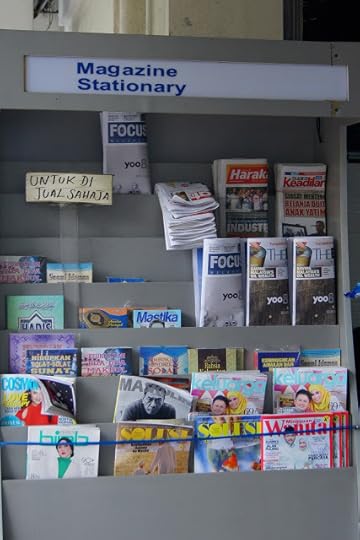 First of all, there is obvious movement going on here. You can see pages flapping and bowing. Some are leaning forward. OK, most of these magazines are indeed stationary. Those at the bottom even have a restraining strap; they must be restless. In defense of this sign-maker, native speakers make this mistake fairly often--stationary for stationery. I've seen this mistake in the UK as well.
First of all, there is obvious movement going on here. You can see pages flapping and bowing. Some are leaning forward. OK, most of these magazines are indeed stationary. Those at the bottom even have a restraining strap; they must be restless. In defense of this sign-maker, native speakers make this mistake fairly often--stationary for stationery. I've seen this mistake in the UK as well.
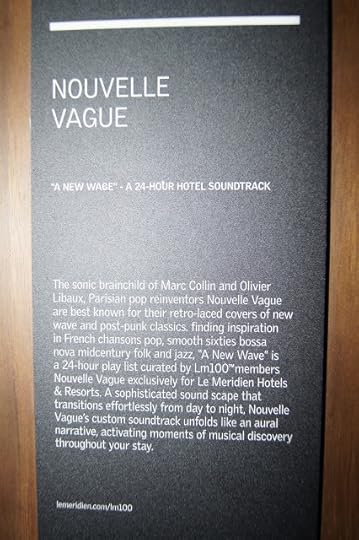 This is a beautiful sign, and the music piped into this elevator is just as pretty. While 99% of this is perfect English--playlist not play list and soundscape not sound scape--the most glaring thing about this sign, notwithstanding the obnoxious lighting, is the mistake at the top: "A NEW WAGE". Ahhhhhhhhh. You make a beautiful sign, put it in hundreds of hotels around the world, and you translate Nouvelle Vague as New Wage. It really is a pretty sign, though.
This is a beautiful sign, and the music piped into this elevator is just as pretty. While 99% of this is perfect English--playlist not play list and soundscape not sound scape--the most glaring thing about this sign, notwithstanding the obnoxious lighting, is the mistake at the top: "A NEW WAGE". Ahhhhhhhhh. You make a beautiful sign, put it in hundreds of hotels around the world, and you translate Nouvelle Vague as New Wage. It really is a pretty sign, though.
I must be off,
Christopher
________________________________________
Christopher Allen is the 2015 recipient of the Ginosko Literary Journal's award for flash fiction. His work appears in Indiana Review, Eclectica Magazine, Night Train, Camroc Press Review, Contrary and over 100 other journals. Read his book reviews in [PANK), The Lit Pub, Necessary Fiction and more. A former finalist at Glimmer Train, Allen is also a multiple nominee for Best of the Net and the Pushcart Prize. Originally from Tennessee, Allen now splits his time between Munich and Dublin. He is the managing editor of SmokeLong Quarterly.
 As a teacher of English as a second language, I know this one is hard. Non-native speakers don't always hear the difference between of and off. I like this one a lot. It takes the bossy imperative "Take off your shoes" and transforms it into a nicer, friendlier "Take of your shoes" as if my shoes are in that pot and I can take as much of them as I want. I like that. Thank you, Koh Samui, for being so generous with my shoes.
As a teacher of English as a second language, I know this one is hard. Non-native speakers don't always hear the difference between of and off. I like this one a lot. It takes the bossy imperative "Take off your shoes" and transforms it into a nicer, friendlier "Take of your shoes" as if my shoes are in that pot and I can take as much of them as I want. I like that. Thank you, Koh Samui, for being so generous with my shoes.  But what if I want to wear a bikini or a halter top tentatively, which would most definitely be the case? Or demurely? I'd like to think of myself as a demure clothes wearer. Don't get me started on that blue sign. What the hell is a towei? And forget the Oxford comma. What about commas at all? And do they have only one scarf? Ick: bacteria farm. On another subject, this sign borders on soft porn. I can imagine old guys staring at it for days.
But what if I want to wear a bikini or a halter top tentatively, which would most definitely be the case? Or demurely? I'd like to think of myself as a demure clothes wearer. Don't get me started on that blue sign. What the hell is a towei? And forget the Oxford comma. What about commas at all? And do they have only one scarf? Ick: bacteria farm. On another subject, this sign borders on soft porn. I can imagine old guys staring at it for days.  I'd like to take the lone apostrophe in the sign above this one and insert it here. This sign is, as the sign says, from the city of Kandy in Sri Lanka, and the city is relatively free of litter.
I'd like to take the lone apostrophe in the sign above this one and insert it here. This sign is, as the sign says, from the city of Kandy in Sri Lanka, and the city is relatively free of litter.  OK, there is generally a problem when it comes to plurals--I get that. This sign is also from the world heritage city of Kandy, Sri Lanka, where considerably more than one foreign guest come to visit a temple that preserves one of The Buddha's teeth.
OK, there is generally a problem when it comes to plurals--I get that. This sign is also from the world heritage city of Kandy, Sri Lanka, where considerably more than one foreign guest come to visit a temple that preserves one of The Buddha's teeth.  Um, this is kind of scary actually, and I'm not only talking about the missing space after the comma. Please tell me Othopedic surgery is a thing. When I looked it up on Webster.com one of the alternatives Webster gave me was "spotted dick". Hee hee hee. That made my morning. Seriously though, wouldn't an orthopedist know how to spell his/her own profession in English? Also on Koh Samui, Thailand.
Um, this is kind of scary actually, and I'm not only talking about the missing space after the comma. Please tell me Othopedic surgery is a thing. When I looked it up on Webster.com one of the alternatives Webster gave me was "spotted dick". Hee hee hee. That made my morning. Seriously though, wouldn't an orthopedist know how to spell his/her own profession in English? Also on Koh Samui, Thailand.  First of all, there is obvious movement going on here. You can see pages flapping and bowing. Some are leaning forward. OK, most of these magazines are indeed stationary. Those at the bottom even have a restraining strap; they must be restless. In defense of this sign-maker, native speakers make this mistake fairly often--stationary for stationery. I've seen this mistake in the UK as well.
First of all, there is obvious movement going on here. You can see pages flapping and bowing. Some are leaning forward. OK, most of these magazines are indeed stationary. Those at the bottom even have a restraining strap; they must be restless. In defense of this sign-maker, native speakers make this mistake fairly often--stationary for stationery. I've seen this mistake in the UK as well.  This is a beautiful sign, and the music piped into this elevator is just as pretty. While 99% of this is perfect English--playlist not play list and soundscape not sound scape--the most glaring thing about this sign, notwithstanding the obnoxious lighting, is the mistake at the top: "A NEW WAGE". Ahhhhhhhhh. You make a beautiful sign, put it in hundreds of hotels around the world, and you translate Nouvelle Vague as New Wage. It really is a pretty sign, though.
This is a beautiful sign, and the music piped into this elevator is just as pretty. While 99% of this is perfect English--playlist not play list and soundscape not sound scape--the most glaring thing about this sign, notwithstanding the obnoxious lighting, is the mistake at the top: "A NEW WAGE". Ahhhhhhhhh. You make a beautiful sign, put it in hundreds of hotels around the world, and you translate Nouvelle Vague as New Wage. It really is a pretty sign, though. I must be off,
Christopher
________________________________________
Christopher Allen is the 2015 recipient of the Ginosko Literary Journal's award for flash fiction. His work appears in Indiana Review, Eclectica Magazine, Night Train, Camroc Press Review, Contrary and over 100 other journals. Read his book reviews in [PANK), The Lit Pub, Necessary Fiction and more. A former finalist at Glimmer Train, Allen is also a multiple nominee for Best of the Net and the Pushcart Prize. Originally from Tennessee, Allen now splits his time between Munich and Dublin. He is the managing editor of SmokeLong Quarterly.
Published on December 11, 2015 00:44
December 9, 2015
Traveling in 2015
 We have become wary travelers. News of the crimes committed in Paris was still fresh when we landed in Kochi, India. A cruise ship with 3000 people on board seemed like an easy target for hate crimes. And we were just about to get on one.
We have become wary travelers. News of the crimes committed in Paris was still fresh when we landed in Kochi, India. A cruise ship with 3000 people on board seemed like an easy target for hate crimes. And we were just about to get on one.Check-in, customs and security at the cruise terminal all went so fast. Our bags were on the truck to be transported to the ship before I noticed that no one else had noticed there were no cabin tags on the bags. The guys on the truck had loaded three bags with no cabin tags, and the security guys at the scanner hadn't noticed the missing cabin tags. Everyone seemed a little tired, a bit unconcentrated. It was hot and humid and hectic.
"Take those bags down! Those there! Yes, that ugly one. Yes, that one that looks like it's been through a shredder!" I shouted and arguments in myriad dialects ensued. They couldn't take bags off the truck once they'd been loaded. But of course they had to take them down and let me put the cabin tags on them. How would they take them to the right cabin?
When I finally convinced the guys on the truck--by yelling louder--to give me back the bags, the Indian authorities started shouting at me that the bags had to go through the scanner.
"They are having to be going through the security facility conveyor machine!"
"They are having to do what? Through what?"
"They must be going through--"
"They've already been through--"
"They have to be going through--"
"Stop putting -ing on all your verbs!" I shouted back, and instead of doing the right thing--to put them through the scanner again--the authorities backed down. So lax was security in Kochi.
But let me take a step back and tell you a bit about the e-visa joke's-on-you India has going. If you are entering India only once as a tourist, you might be tempted to apply for an e-visa online. Don't do this. Go ahead and apply for the multi-entry visa. It will save you time in the long run. I thought once I applied for our e-visas online--you still have to have a picture made in the Indian format, fill out a rather long form and scan your passport into their system--that we'd sail through immigration in Kochi like a butter chicken. Sadly, if you have an e-visa, you don't go through immigration with all the other smarter people who took the time to get a multi-entry visa; instead you are shuffled off to a little room with the other e-visa dopes, and you have to sit there patiently while the immigration officer wipes down his fingerprint machine for the umpteenth time because nothing works quite right here. And he's trying to get the fingerprints from the guy who's six or seven people in front of you. The people with their multi-entry visas are already slurping their welcome drinks at their hotels.
Getting a taxi at the Kochi airport is also a bit inconvenient, but if you know what to do it should be easy-peasy. As in many countries where corruption is rampant, you can't just walk out of an airport and get into a taxi. You have to pay someone at a desk and get a voucher. It's referred to as "Pre-paid" in Kochi. And that's what the taxi drivers are saying when you are trying to talk to them. "Pre-paid?" "Pre-paid?" It sounds more like "Pripid," which is the reason you keep saying "Excuse me?" and they keep saying "Pripid?"
The drive to our hotel took about seven centuries of Indian music. I couldn't tell you where one stopped and the other started, so I can't tell you how far it was according to the I Must Be Off Pop Song distance meter. Go to the bathroom at the airport--that's all I have to say on this one.
Oh, what a tangent all that was--but of course if you're reading this post because you were considering getting an e-visa for India, I hope you found that tangent helpful. What I really wanted to talk about was traveling in 2015 when a lot of people are more wary than they've ever been. We should be wary, but we should keep traveling.
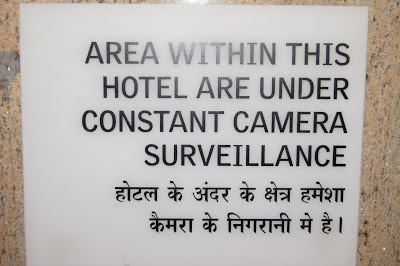 After the crimes committed in Paris recently, the Indian government was quick to announce it was doing everything in its power to keep India safe. There was a security check before we entered our hotel but not the type where they check under the car. Did I feel safe? I did--until we took a walk around the grounds of the hotel and along the Backwater. On the other side of the water there were four or five men dressed in white. I assume they were Moslem, but I wasn't really thinking about them. I live in a place where I see people dressed in many different ways. But at some point their attention was drawn to me and they started shouting. When I didn't react, they raised their fists in unison and held that position for quite a while--which was unnerving. It took a couple of seconds for me to understand the scene. I was a white guy on the grounds of the Le Meridien hotel, a French hotel, the day after the Paris crimes. Ah, I thought. I see. There are people out there who hate what they think you stand for; and while it would be wrong to hate them in return, it's certainly smart to be aware of them. And when you're traveling in a foreign country, you should have both eyes open, know a bit about the demographics.
After the crimes committed in Paris recently, the Indian government was quick to announce it was doing everything in its power to keep India safe. There was a security check before we entered our hotel but not the type where they check under the car. Did I feel safe? I did--until we took a walk around the grounds of the hotel and along the Backwater. On the other side of the water there were four or five men dressed in white. I assume they were Moslem, but I wasn't really thinking about them. I live in a place where I see people dressed in many different ways. But at some point their attention was drawn to me and they started shouting. When I didn't react, they raised their fists in unison and held that position for quite a while--which was unnerving. It took a couple of seconds for me to understand the scene. I was a white guy on the grounds of the Le Meridien hotel, a French hotel, the day after the Paris crimes. Ah, I thought. I see. There are people out there who hate what they think you stand for; and while it would be wrong to hate them in return, it's certainly smart to be aware of them. And when you're traveling in a foreign country, you should have both eyes open, know a bit about the demographics.Kochi is 47% Hindu, 35% Christian, 17% Muslim and the rest Buddhist and a host of other religions. The city has the fourth highest crime rate in India but Kochi is obviously a community trying to get a handle on its problems. And one of them is security.
If the lax security we encountered at the cruise terminal in Kochi is any indication of how "safe" India is, then I'm skeptical. Of course our cruise--which I'll talk about in another more lighthearted post--went well with no other security issues I was aware of. When you board a cruise, there is a scanner very much like at the airport, but it always seems to be more relaxed, like a formality. Too relaxed?
What are your feelings about traveling in 2015? Have you been more careful than usual? Have you changed plans or habits?
I must be off,
Christopher
____________________________________________
Christopher Allen is the 2015 recipient of the Ginosko Literary Journal's award for flash fiction. His work appears in Indiana Review, Eclectica Magazine, Night Train, Camroc Press Review, Contrary and over 100 other journals. Read his book reviews in [PANK), The Lit Pub, Necessary Fiction and more. A former finalist at Glimmer Train, Allen is also a multiple nominee for Best of the Net and the Pushcart Prize. Originally from Tennessee, Allen now splits his time between Munich and Dublin.
Published on December 09, 2015 05:19
October 16, 2015
Is South Africa Safe?
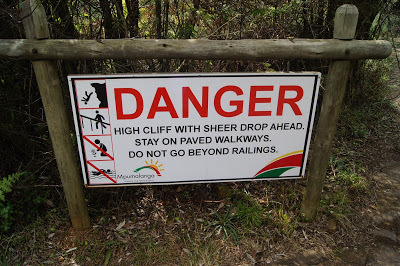 I was apprehensive. When I told folks I was going camping in a motorhome for three weeks in South Africa, the first question they asked--always--was do you think that's safe? It made such an impression on me that I actually broke my rule about being totally ignorant of the place and did a bit of research. After all, I'm not the biggest of fan of being knifed and robbed in my sleep.
I was apprehensive. When I told folks I was going camping in a motorhome for three weeks in South Africa, the first question they asked--always--was do you think that's safe? It made such an impression on me that I actually broke my rule about being totally ignorant of the place and did a bit of research. After all, I'm not the biggest of fan of being knifed and robbed in my sleep.How dangerous is South Africa? I'm not going to pretend to be able to answer this question for the entire country, but I can give you a good picture of how safe I felt--as well as how paranoid I felt due to the reading I'd done beforehand.
At the beginning of our trip we traveled in a motorhome during low season in and around Kruger National Park. We were a spectacle to be sure. We got stares. When we pulled up to traffic lights we made sure our doors were locked. I'd read about carjackings at traffic lights, where you'll find young guys trying to sell anything from USB sticks to oranges. They're not criminals; they're salesmen who work all day in the hot sun. There's probably a mafia behind it; the Koch Brothers probably have a stake in them. If you don't need a USB stick or a bag of oranges, keep your windows up and your doors locked.
(What you should do, even though it has nothing to do with safety: stop and buy some avocados from the women on the side of the street. The avocados are better and cheaper than the ones in the store--at least around Kruger National Park and Grasskop. For 25 rand (3euros) we got a net of 7 avocados, and they were all great. We had worse luck with roadside avocados in the South.)
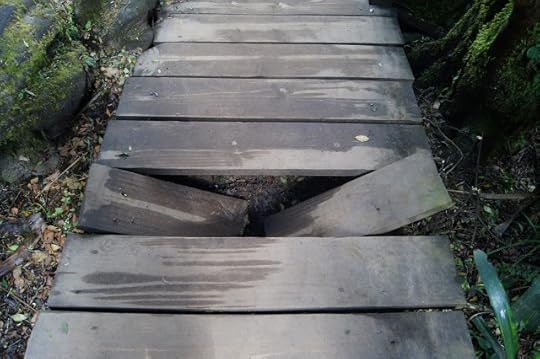 In terms of safety, you're more likely to fall and break your ankle than to be robbed.
In terms of safety, you're more likely to fall and break your ankle than to be robbed. Beware of the vendors selling what looks like figures made from various types of wood. It's all cheap wood stained with shoe polish. They'll tell you their uncle hand-sculpted the elephant, but you'll find that exact elephant in the next village. That uncle is busy. We made the mistake of buying a foldable table that this uncle had made. By the time we were ready to fly home, it had mold all over it and its coat of shoe polish was rubbing off. Even if the quality of the knick-knacks was questionable, I still felt these people were trying to make a living the best way they could. If you buy something from them just make sure you know what you're buying, which is basically crap.
 Kruger National Park
Kruger National ParkThe most dangerous animal in Kruger National Park is apparently the African Buffalo, although I didn't feel very threatened. Of course, I also hadn't read anything about the beast before the trip. These animals are so ornery that, though they look like cows with wacky horns, they've never been domesticated. They're one of The Big Five in the Africa because of how dangerous they are to hunt. They gang up on hunters, which is odd since they look so dumb. Stay away from the cows with the goofy horns.
Elephants can also become aggressive. The speed limit in the park is very low, and there are police giving tickets. You could drive around a corner and find yourself up an elephant's behind. As long as you drive slowly, you'll probably be safe. Elephants are used to cars.
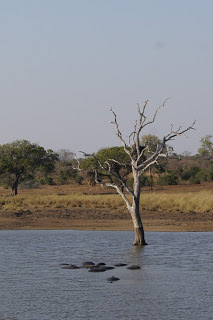 Although hippos are considered extremely dangerous, you probably won't get close enough to one to worry about it. If you have a camera like mine, you probably won't even get close enough to get a good picture of one. The same is true for lions.
Although hippos are considered extremely dangerous, you probably won't get close enough to one to worry about it. If you have a camera like mine, you probably won't even get close enough to get a good picture of one. The same is true for lions. 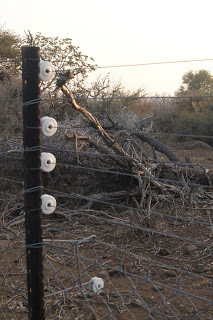 All campsites in Kruger National Park have Jurassic Park-style fences, so you're safe from large animals. Your breakfast, though, is not safe from the pesky birds. If you leave your breakfast to go into your motorhome for just two seconds, your breakfast table will be all aflurry with three or four lovely species of African birds. I'd have my camera ready If I were you.
All campsites in Kruger National Park have Jurassic Park-style fences, so you're safe from large animals. Your breakfast, though, is not safe from the pesky birds. If you leave your breakfast to go into your motorhome for just two seconds, your breakfast table will be all aflurry with three or four lovely species of African birds. I'd have my camera ready If I were you.Cape Town
The moment we arrived in Cape Town we headed for the Table Mountain with the intention of climbing up that puppy. There are a couple of options. You can take the longer 5-hour route or the shorter, much much steeper 2.5-hour route. We took the shorter route because we didn't really know how steep it was going to be. It's a very steep walk. We nearly died. Seriously. I kept waiting for the laggers (I was always in front because I'm so damn fit) to keel over from a heart attack, effectively ruining everyone's day, but by some miracle no one died).
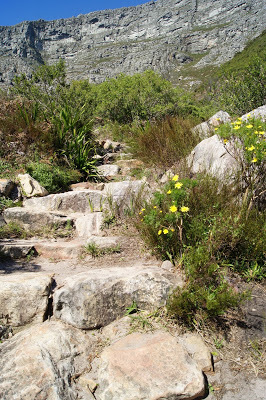 Before the trip, I read that you need to be vigilant while hiking, that there are robbers on the trails. The guy who was parking cars on the street corroborated this by warning us not to park too far away from the other cars he was parking. "There are robbers up here," he said.
Before the trip, I read that you need to be vigilant while hiking, that there are robbers on the trails. The guy who was parking cars on the street corroborated this by warning us not to park too far away from the other cars he was parking. "There are robbers up here," he said."And so you'll protect our motorhome for a few rand?" I asked.
"Yes," he said.
"Are you going to stay close to our motorhome?" I asked.
"Yes," he lied.
There are robbers in Cape Town, and most of them are parking your cars.
The second we started up the mountain I spotted three teenagers fall in behind us. I worried the whole 3 hours (it took us 3 hours instead of 2.5) that we'd be robbed and left for dead since none of the other panting, worn-out hikers would be able to carry us off that mountain. In the end, we had nothing to worry about. They were just three teenagers going for a very steep walk. Still, stay in a group when you hike.
We felt safe in Cape Town, but then we didn't go out at night or go traipsing through townships. We were too spooked by what we'd read before the trip. Actually, travel guides say an organized township tour should be a rewarding experience. I understand that this brings badly needed funds to the residents of these communities, but I couldn't bring myself to do it. If you've done this, we'd all appreciate hearing about your experience.
The Western Cape in general is an affluent wine-growing region dappled with quaint tourist-friendly villages, wineries and shanty towns. Yes, shanty towns. There is still very much a racial divide here. It seems to me black people harvest what white people drink.
Johannesburg
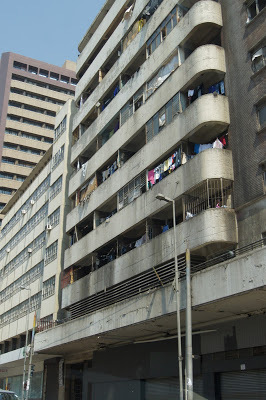 Is Johannesburg safe? No. That's the simple answer. We'd planned to have a walk around the center of Joburg on the Sunday before we flew back to Germany. We didn't get out of the car.
Is Johannesburg safe? No. That's the simple answer. We'd planned to have a walk around the center of Joburg on the Sunday before we flew back to Germany. We didn't get out of the car.The center of Joburg has been destroyed by the turbulent end of Apartheid. The businesses have deserted this area, leaving it to the masses of people who flooded in from the surrounding townships. Prostitutes linger in the doorways. Garbage is everywhere. Laundry hangs out of windows on the 20th floor of a building that was once the headquarters for a bank.
Yet if you drive just a few minutes outside the center of Joburg, you'll find a fairly normal city. There are beautiful gardens, nice restaurants and shops, churches and sports facilities--everything you'd expect in a functioning society. Then if you drive a few more miles, you come to Sandton, where all the businesses escaped to. These places seemed relatively normal and safe to me. But then there are also security guards everywhere you look.
Camping in South Africa
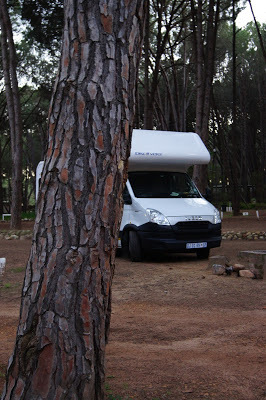 I worried a lot about leaving our passports in the motorhome. Usually, we kept our valuables in our backpacks, but it's also not smart to keep all your valuables in one place. Maybe we were stupid, but we often parked our motorhome at the edge of a town and spent hours browsing through shops selling the same malachite bracelets. We always returned to a motorhome unmolested, but maybe we were just lucky. When we returned our motorhome on the last day, the employee who checked us in asked us if the motorhome's safe had worked properly. "Safe?" we said. "What safe?" Yeah, we were just lucky.
I worried a lot about leaving our passports in the motorhome. Usually, we kept our valuables in our backpacks, but it's also not smart to keep all your valuables in one place. Maybe we were stupid, but we often parked our motorhome at the edge of a town and spent hours browsing through shops selling the same malachite bracelets. We always returned to a motorhome unmolested, but maybe we were just lucky. When we returned our motorhome on the last day, the employee who checked us in asked us if the motorhome's safe had worked properly. "Safe?" we said. "What safe?" Yeah, we were just lucky. We stayed in more than ten caravan parks around South Africa and felt safe in all of them. Most of them had security guards walking or riding bikes around the sites all night. All of them had secure gates at the entrances--except our first campsite. We arrived very late at night because we had trouble finding the caravan park. We had to stop and ask for directions. I even had to speak to someone, which was an awful experience. Opening my mouth and asking for directions: just awful. When we finally arrived, there was no one at the gate and the gate was open. The next morning, there was no one at the gate and the gate was open. Suckers!
Have you traveled through South Africa in a motorhome? I'd love to hear about your own experiences, whether you felt it was safe.
I must be off,
Christopher
______________________________________________
Christopher Allen is the 2015 recipient of the Ginosko Literary Journal's award for flash fiction. His work appears in Indiana Review, Eclectica Magazine, Night Train, Camroc Press Review, Contrary and over 100 other journals. Read his book reviews in [PANK), The Lit Pub, Necessary Fiction and more. A former finalist at Glimmer Train, Allen is also a multiple nominee for Best of the Net and the Pushcart Prize. Originally from Tennessee, Allen now splits his time between Munich and Dublin.
Published on October 16, 2015 09:06
October 15, 2015
Kaleidoscope -- Writers Abroad Anthology 2015
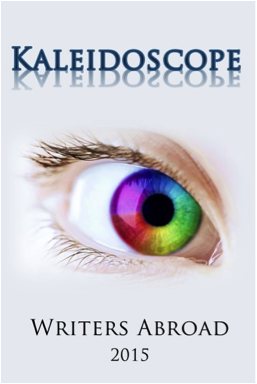 Did you know that 2015 is the year of LIGHT? Well, it is. And Writers Abroad, a group of talented expat writers, have just published their 2015 anthology on the theme of light. All of the stories and poems are written by writers who are living, or who have lived, in another country. As you know, I'm very interested in the expat experience. I'm an expat myself, and I interview expat authors here at I Must Be Off! so of course I've interviewed a couple of the Writers Abroad writers. Sadly, I was never able to get an interview from Jany Gräf or Mary Davies, two WA members that passed away in 2014. Kaleidoscope is dedicated to Jany and Mary.
Did you know that 2015 is the year of LIGHT? Well, it is. And Writers Abroad, a group of talented expat writers, have just published their 2015 anthology on the theme of light. All of the stories and poems are written by writers who are living, or who have lived, in another country. As you know, I'm very interested in the expat experience. I'm an expat myself, and I interview expat authors here at I Must Be Off! so of course I've interviewed a couple of the Writers Abroad writers. Sadly, I was never able to get an interview from Jany Gräf or Mary Davies, two WA members that passed away in 2014. Kaleidoscope is dedicated to Jany and Mary. Writers Abroad always donates their proceeds to a charitable organization. This year it's Room to Read , an organization that provides reading material and education to children around the world. When you buy a Writers Abroad book, you support early childhood literacy.
And because early childhood literacy is also very close to my heart, you can win Kaleidoscope simply by replying to this post with "I support early childhood literacy" and your email address. The first five people who respond will receive the Kaleidoscope: Writers Abroad 2015. Be patient with Blogger. It may take you a few minutes to leave a comment if you're new to Blogger. I've apologized a hundred times for this platform.
I must be off,
Christopher
________________________________________
Christopher Allen is the 2015 recipient of the Ginosko Literary Journal's award for flash fiction. His work appears in Indiana Review, Eclectica Magazine, Night Train, Camroc Press Review, Contrary and over 100 other journals. Read his book reviews in [PANK), The Lit Pub, Necessary Fiction and more. A former finalist at Glimmer Train, Allen is also a multiple nominee for Best of the Net and the Pushcart Prize. Originally from Tennessee, Allen now splits his time between Munich and Dublin.
Published on October 15, 2015 14:56
October 12, 2015
Publishing News
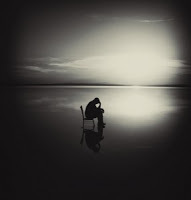 –Art by Milan Vopálenský & Esmahan ÖzkanIf you haven't already popped by these wonderful places, I hope you will. I'm grateful to have been included in these journals:
–Art by Milan Vopálenský & Esmahan ÖzkanIf you haven't already popped by these wonderful places, I hope you will. I'm grateful to have been included in these journals: Literary Orphans -- "The Ground Above My Feet"
For at least a few years now, I've been thinking about fathers, not necessarily my own father but maybe myself as father or non-father. This story is another brick in this enormous wall. I'm not really sure what I'm building yet, but I know I need to write about it.
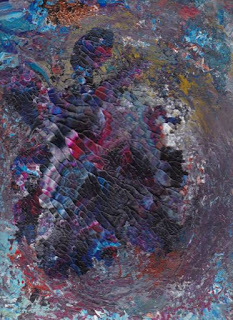 "Fossilized" by W. Jack SavageChange Seven Magazine -- "One for Rainbow"
"Fossilized" by W. Jack SavageChange Seven Magazine -- "One for Rainbow"Here is another character who needs a father. I can't get away from it. This character has everything--the sticky love of a grandmother, education and a comfortable home--everything except a father.
Please have a read. If you have time to share your love with someone today, I hope you'll share it with a literary journal. These people put in hours and hours to provide literature free to anyone online just as we do at SmokeLong Quarterly .
 I can't imagine a better world than a more literate world. I support Dolly Parton's Imagination Library--a project to provide age-appropriate books to children around the world. Literacy matters, and it has to start early. I'll be donating as always this Christmas, and I hope you will too.
I can't imagine a better world than a more literate world. I support Dolly Parton's Imagination Library--a project to provide age-appropriate books to children around the world. Literacy matters, and it has to start early. I'll be donating as always this Christmas, and I hope you will too. I must be off,
Christopher
_______________________________________
Christopher Allen is the 2015 recipient of the Ginosko Literary Journal's award for flash fiction. His work appears in Indiana Review, Night Train, Camroc Press Review, Contrary and over 100 other journals. Read his book reviews in [PANK), The Lit Pub, Necessary Fiction and more. A former finalist at Glimmer Train, Allen is also a multiple nominee for Best of the Net and the Pushcart Prize. Originally from Tennessee, Allen now splits his time between Munich and Dublin.
Published on October 12, 2015 14:40
September 30, 2015
The 2015 I Must Be Off! Travel Writing Competition -- The Winners!
 I hope you've been keeping up with this year's competition. We had an incredible variety of entries from almost all corners of the planet. Over 300 people from 43 countries sent in stories. Many of them, even though they did not make it into the semifinalist and finalist rounds, were memorable and very well written. Narrowing such a wide pack down to 30 semifinalists was very difficult, and shaving that number down to 10 finalists was Herculean.
I hope you've been keeping up with this year's competition. We had an incredible variety of entries from almost all corners of the planet. Over 300 people from 43 countries sent in stories. Many of them, even though they did not make it into the semifinalist and finalist rounds, were memorable and very well written. Narrowing such a wide pack down to 30 semifinalists was very difficult, and shaving that number down to 10 finalists was Herculean.Much thanks goes to Catherine Sweeney, this year's judge*. She loved all of the top ten entries, so it was very difficult for her to choose "winners". Winners, though, must be chosen in a competition. So here they are:
First Place A Leaf on the Wind by Joel Hindson (UK)
Second PlaceBurning My Boots in Cabo Fisterra by Gabriella Brand (USA)
Highly CommendedDiscovering Hen Rice in Viet Nam by Chris Galvin (Canada)Sweet Homes by David Joseph (USA)Crossing the Gibb by Gillian Brown (Scotland/Australia)
Readers' Choice AwardDiscovering Hen Rice by Chris Galvin (Canada)
The entries with the highest number of comments and hits divided by the number of days online: Barbara Amalberti's "Vientiane: Then and Now" (453÷54, 13 comments), Stacey Venzel's "On a Terrace in Peru" (458÷37; 18 comments) Maricarmen Ferrant's "A Vision Called Tutotepec" (688÷49; 9 comments), David Joseph's "Sweet Homes" (650÷43; 10 comments), and Chris Galvin's "Discovering Hen Rice in Viet Nam" (1432÷46; 18 comments). Barbara Vientiane is from Italy, Stacey Venzel from the USA, Maricarmen Ferrant from Mexico, David Joseph from the USA, and Chris Galvin from Canada.
Again, thank you to everyone who entered the 2015 I Must Be Off! Travel Essay competition. Congratulations to the finalists and the semifinalists. As this is a free competition, you haven't lost. You've written, and I hope you'll continue to write. I'll be here next year, and I hope you'll participate again. As always it will be free.
Until next year . . .
I must be off,
Christopher
*All entries were read blind by the judge, which means all authors' names were removed from the entries.
____________________________________________
Christopher Allen is the 2015 recipient of the Ginosko Literary Journal's award for flash fiction. His work appears in Indiana Review, Night Train, Camroc Press Review, Contrary and over 100 other journals. Read his book reviews in [PANK), The Lit Pub, Necessary Fiction and more. A former finalist at Glimmer Train, Allen is also a multiple nominee for Best of the Net and the Pushcart Prize. Originally from Tennessee, Allen now splits his time between Munich and Dublin.
Published on September 30, 2015 05:39
September 11, 2015
The Big Five
If you're planning a trip to a national park in Africa, have you saved room in your backpack for one of these?

If you haven't, you should--not because you'll look sexier but because you'll see sexier. I made do with my pitiful little Sony, so the quality of the photos below suffers in many ways. Many times I wasn't able to zoom in as much as I'd wanted to. Some photos are blurry, taken through the windshield of our vehicle. Disclaimers are boring, I know. I did do the best I could with the equipment I had. If you want to buy me that thing up there for Christmas, I won't stop you.
Before I set out on my South African adventure, I knew a little about South Africa. I knew of course who Nelson Mandela was, I knew that South Africa hosted a World Cup, that South African wine is pretty good, that Apartheid was over and that Africaans was the official language. I did not know anything about The Big Five. What a dunce.
The Big Five is all anyone ever talks about in South Africa. Forget Apartheid. There are shops called The Big Five (there are none called "Apartheid"). Every belt and bracelet in those shops has The Big Five on it. You can buy Big Five ashtrays and Big Five statues. Big Five dishtowels and Big Five chocolates. Big Five keychains and Big Five ties.
"Did you see The Big Five?" one of my students asked me this week when I got back to Munich.
"Oh goodness. You too? Was I the only one on earth who didn't know what The Big Five was?"
"Yes. So did you?"
"Do what?"
"See The Big Five?"
"Yes, I did--apparently."
"Ah," he said. "You had a really bad camera."
"Yes."
"Next time you go," he said, "you need to take one of THESE ."
"I know!"
So what is The Big Five? And how did The Big Five come to be called The Big Five? Welcome to the motherload of knowledge, dear dear I Must Be Off! readers. You're about to learn so much.
Each of the animals making up The Big Five was chosen for its difficulty of hunting on foot. Not for its beauty or size but for how hard it is to kill.
The African Elephant --
Or in Africaans, the Olifant! I like olifant much better actually, so I'm just going to use it. The African bush olifant is the largest living terrestrial animal, males standing ten to thirteen feet at the shoulder and weighing 10,360–13,330 pounds; females are a bit more petite. Here is a picture of one I took at a watering hole. I'm particularly proud of how close I was able to get. I had to climb up in a very big tree to get this bird's-eye view:
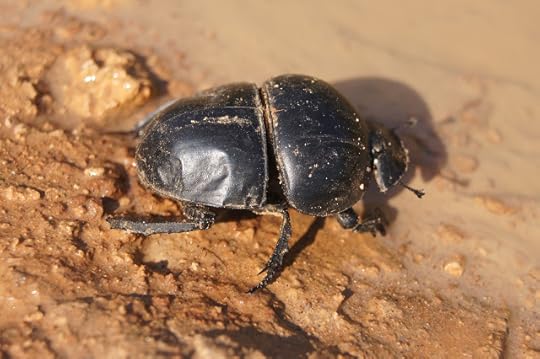 The African Bush Elephant
The African Bush Elephant
The African bush olifant eats almost a thousand pounds of vegetation a day, yet only about 40 percent of this is entirely digested. Olifant poop is probably the most common sight in South African national parks. Easily reconizable, they are the bowling balls littering the roads.
*
The African Lion --
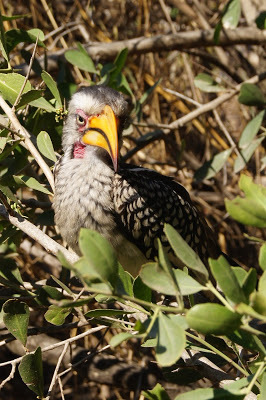 The African LionI just have to say upfront that I have not seen The Lion King; so when a helpful tourist pulled up to our vehicle and whispered "lion," pointing into the bush a million miles away, I wasn't exactly sure what I was searching for and of course not really sure why the guy was whispering. When I finally saw it, I was elated. My first sighting of a lion in the wild (well, it's a national park, but I assume there's no breakfast buffet or room service)!
The African LionI just have to say upfront that I have not seen The Lion King; so when a helpful tourist pulled up to our vehicle and whispered "lion," pointing into the bush a million miles away, I wasn't exactly sure what I was searching for and of course not really sure why the guy was whispering. When I finally saw it, I was elated. My first sighting of a lion in the wild (well, it's a national park, but I assume there's no breakfast buffet or room service)!
As you can see on the right here, the African Lion has a bit of an attitude--King of the jungle and all. Sadly, this beautiful animal lives only around 14 years in the wild, 20 in captivity (where there is a breakfast buffet). There are apparently 12 subspecies and even a couple of hybrids with tigers. I'm thinking the fellow on the right here might be a hybrid with Donald Trump.
Lions are noctural or crepuscular hunters. They sleep a lot during the day, so I think we were lucky to get such a good picture of this one awake. He does appear a bit drowsy, though.
*
The Cape Buffalo --
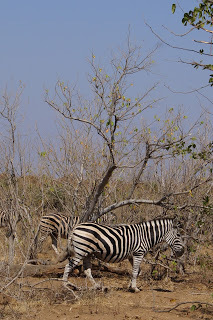 The Cape BuffaloThe Cape buffalo is apparently--after the mosquito--the most dangerous animal in Africa, killing more hunters than any other animal. They gang up on hunters, so good on 'em. Maybe Walter Palmer will choose it as his next project. We can only hope.
The Cape BuffaloThe Cape buffalo is apparently--after the mosquito--the most dangerous animal in Africa, killing more hunters than any other animal. They gang up on hunters, so good on 'em. Maybe Walter Palmer will choose it as his next project. We can only hope.
Due to their extremely aggressive nature, they have never been domesticated. While the African buffalo is highly susceptible to disease, populations remain strong with around 900,000 animals worldwide. Here are a couple of them on the left.
I didn't know how dangerous the Cape buffalo was when I took this picture--hell, I didn't even know there was a Cape buffalo. Apparently, when I took this shot, I'd never been closer to death.
It bears mentioning here that you are not allowed to leave your vehicle in a national park. There are a few areas where you are allowed to leave your car, but of course there are also signs warning you that doing so might make you a lion's lunch. I rolled down my window to get a good shot of these beautiful Cape buffalo. It was exhilarating as most bone-headed things are. I'm lucky to be alive.
*
The African Leopard --
I'm going to quote straight from Wikipedia on this one because I didn't believe it myself until I read it here: "African leopards exhibit great variation in coat color, depending on location and habitat. Coat color varies from pale yellow to deep gold or tawny, and sometimes black [emphasis added], and is patterned with black rosettes while the head, lower limbs and belly are spotted with solid black." Sometimes black! It's quite possible that I've taken a photo of a very rare leopard. I couldn't see its belly to see if the requisite spots--or limbs--were there, but this one is definitely black. And look at those beautiful rosettes!
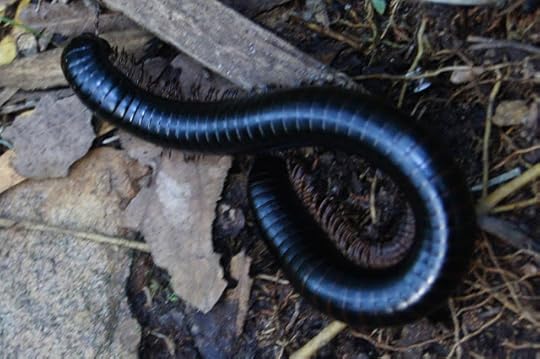 The African Leopard
The African Leopard
Leopards are quite difficult to spot--pun intended. They're usually lounging around on trees, but this one was just lying there in the middle of the path in the Knysna National forest, which allowed me the rare opportunity of walking through a rainforest on my own with no guide--risking my life once more to bring you up-close images of The Big Five.
This brings us to the last of the The Big Five. It's actually two species.
*
The White/Black Rhinoceros --
I have to apologize for the quality of this photo. This prime specimen darted across the road before I could zoom in on it. I can't tell whether it's a white or a black rhino (maybe a gray one?), so I'm just going to let it be both. The collective noun for a group of rhinoceroses is a crash, which is my favorite bit of useless information today. You will seldom see a crash of rhinos since male rhinos--like many animals in The Big Five--are solitary creatures. A crash, mostly females, may consist of up to 14 animals.
 The White/Black Rhinoceros
The White/Black Rhinoceros
Interestingly, there's a theory that the "white" rhino was not named for its coloring but that "white" is actually a mistranslation of "wyd" from Africaans, which means "wide" referring to the rhino's mouth. This made a lot of sense to me because the German is Breitmaulnashorn (wide-mouthed rhino), and this was confirmed to me by a South African woman at one of our campsites. Wikipedia, though, says this is a bunch of bull.
Have you seen The Big Five while visiting a national park in Africa? I'd love to compare pictures!
I must be off,
Christopher
_______________________________________________
Christopher Allen is the author of Conversations with S. Teri O'Type (a Satire), an episodic adult cartoon about a man struggling with expectations. Allen's writing has appeared in Indiana Review, Night Train, Quiddity, SmokeLong Quarterly: the Best of the First Ten Years anthology, Prime Number Magazine, Contrary, [PANK] blog, Necessary Fiction, Word Riot, Bootsnall Travel, Chicken Soup for the Soul and over 100 other good places. A finalist at Glimmer Train in 2011 and the winner of the Ginosko Literary Journal's Flash Fiction Award in 2015, Allen has been nominated for Best of the Net and the Pushcart Prize twice.

If you haven't, you should--not because you'll look sexier but because you'll see sexier. I made do with my pitiful little Sony, so the quality of the photos below suffers in many ways. Many times I wasn't able to zoom in as much as I'd wanted to. Some photos are blurry, taken through the windshield of our vehicle. Disclaimers are boring, I know. I did do the best I could with the equipment I had. If you want to buy me that thing up there for Christmas, I won't stop you.
Before I set out on my South African adventure, I knew a little about South Africa. I knew of course who Nelson Mandela was, I knew that South Africa hosted a World Cup, that South African wine is pretty good, that Apartheid was over and that Africaans was the official language. I did not know anything about The Big Five. What a dunce.
The Big Five is all anyone ever talks about in South Africa. Forget Apartheid. There are shops called The Big Five (there are none called "Apartheid"). Every belt and bracelet in those shops has The Big Five on it. You can buy Big Five ashtrays and Big Five statues. Big Five dishtowels and Big Five chocolates. Big Five keychains and Big Five ties.
"Did you see The Big Five?" one of my students asked me this week when I got back to Munich.
"Oh goodness. You too? Was I the only one on earth who didn't know what The Big Five was?"
"Yes. So did you?"
"Do what?"
"See The Big Five?"
"Yes, I did--apparently."
"Ah," he said. "You had a really bad camera."
"Yes."
"Next time you go," he said, "you need to take one of THESE ."
"I know!"
So what is The Big Five? And how did The Big Five come to be called The Big Five? Welcome to the motherload of knowledge, dear dear I Must Be Off! readers. You're about to learn so much.
Each of the animals making up The Big Five was chosen for its difficulty of hunting on foot. Not for its beauty or size but for how hard it is to kill.
The African Elephant --
Or in Africaans, the Olifant! I like olifant much better actually, so I'm just going to use it. The African bush olifant is the largest living terrestrial animal, males standing ten to thirteen feet at the shoulder and weighing 10,360–13,330 pounds; females are a bit more petite. Here is a picture of one I took at a watering hole. I'm particularly proud of how close I was able to get. I had to climb up in a very big tree to get this bird's-eye view:
 The African Bush Elephant
The African Bush ElephantThe African bush olifant eats almost a thousand pounds of vegetation a day, yet only about 40 percent of this is entirely digested. Olifant poop is probably the most common sight in South African national parks. Easily reconizable, they are the bowling balls littering the roads.
*
The African Lion --
 The African LionI just have to say upfront that I have not seen The Lion King; so when a helpful tourist pulled up to our vehicle and whispered "lion," pointing into the bush a million miles away, I wasn't exactly sure what I was searching for and of course not really sure why the guy was whispering. When I finally saw it, I was elated. My first sighting of a lion in the wild (well, it's a national park, but I assume there's no breakfast buffet or room service)!
The African LionI just have to say upfront that I have not seen The Lion King; so when a helpful tourist pulled up to our vehicle and whispered "lion," pointing into the bush a million miles away, I wasn't exactly sure what I was searching for and of course not really sure why the guy was whispering. When I finally saw it, I was elated. My first sighting of a lion in the wild (well, it's a national park, but I assume there's no breakfast buffet or room service)! As you can see on the right here, the African Lion has a bit of an attitude--King of the jungle and all. Sadly, this beautiful animal lives only around 14 years in the wild, 20 in captivity (where there is a breakfast buffet). There are apparently 12 subspecies and even a couple of hybrids with tigers. I'm thinking the fellow on the right here might be a hybrid with Donald Trump.
Lions are noctural or crepuscular hunters. They sleep a lot during the day, so I think we were lucky to get such a good picture of this one awake. He does appear a bit drowsy, though.
*
The Cape Buffalo --
 The Cape BuffaloThe Cape buffalo is apparently--after the mosquito--the most dangerous animal in Africa, killing more hunters than any other animal. They gang up on hunters, so good on 'em. Maybe Walter Palmer will choose it as his next project. We can only hope.
The Cape BuffaloThe Cape buffalo is apparently--after the mosquito--the most dangerous animal in Africa, killing more hunters than any other animal. They gang up on hunters, so good on 'em. Maybe Walter Palmer will choose it as his next project. We can only hope.Due to their extremely aggressive nature, they have never been domesticated. While the African buffalo is highly susceptible to disease, populations remain strong with around 900,000 animals worldwide. Here are a couple of them on the left.
I didn't know how dangerous the Cape buffalo was when I took this picture--hell, I didn't even know there was a Cape buffalo. Apparently, when I took this shot, I'd never been closer to death.
It bears mentioning here that you are not allowed to leave your vehicle in a national park. There are a few areas where you are allowed to leave your car, but of course there are also signs warning you that doing so might make you a lion's lunch. I rolled down my window to get a good shot of these beautiful Cape buffalo. It was exhilarating as most bone-headed things are. I'm lucky to be alive.
*
The African Leopard --
I'm going to quote straight from Wikipedia on this one because I didn't believe it myself until I read it here: "African leopards exhibit great variation in coat color, depending on location and habitat. Coat color varies from pale yellow to deep gold or tawny, and sometimes black [emphasis added], and is patterned with black rosettes while the head, lower limbs and belly are spotted with solid black." Sometimes black! It's quite possible that I've taken a photo of a very rare leopard. I couldn't see its belly to see if the requisite spots--or limbs--were there, but this one is definitely black. And look at those beautiful rosettes!
 The African Leopard
The African LeopardLeopards are quite difficult to spot--pun intended. They're usually lounging around on trees, but this one was just lying there in the middle of the path in the Knysna National forest, which allowed me the rare opportunity of walking through a rainforest on my own with no guide--risking my life once more to bring you up-close images of The Big Five.
This brings us to the last of the The Big Five. It's actually two species.
*
The White/Black Rhinoceros --
I have to apologize for the quality of this photo. This prime specimen darted across the road before I could zoom in on it. I can't tell whether it's a white or a black rhino (maybe a gray one?), so I'm just going to let it be both. The collective noun for a group of rhinoceroses is a crash, which is my favorite bit of useless information today. You will seldom see a crash of rhinos since male rhinos--like many animals in The Big Five--are solitary creatures. A crash, mostly females, may consist of up to 14 animals.
 The White/Black Rhinoceros
The White/Black RhinocerosInterestingly, there's a theory that the "white" rhino was not named for its coloring but that "white" is actually a mistranslation of "wyd" from Africaans, which means "wide" referring to the rhino's mouth. This made a lot of sense to me because the German is Breitmaulnashorn (wide-mouthed rhino), and this was confirmed to me by a South African woman at one of our campsites. Wikipedia, though, says this is a bunch of bull.
Have you seen The Big Five while visiting a national park in Africa? I'd love to compare pictures!
I must be off,
Christopher
_______________________________________________
Christopher Allen is the author of Conversations with S. Teri O'Type (a Satire), an episodic adult cartoon about a man struggling with expectations. Allen's writing has appeared in Indiana Review, Night Train, Quiddity, SmokeLong Quarterly: the Best of the First Ten Years anthology, Prime Number Magazine, Contrary, [PANK] blog, Necessary Fiction, Word Riot, Bootsnall Travel, Chicken Soup for the Soul and over 100 other good places. A finalist at Glimmer Train in 2011 and the winner of the Ginosko Literary Journal's Flash Fiction Award in 2015, Allen has been nominated for Best of the Net and the Pushcart Prize twice.
Published on September 11, 2015 10:34
August 31, 2015
An Island in the Baltic Sea by Pamela Hensley
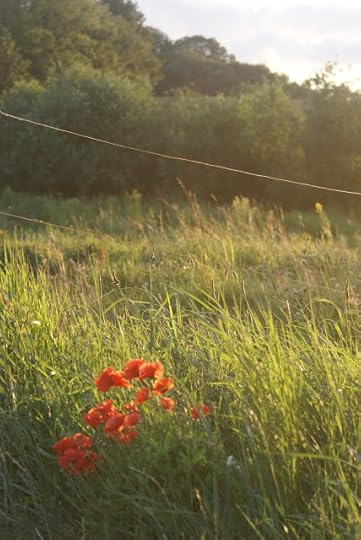 My cousin Martin lives a clay-tiled house on an island in the Baltic Sea. Set back from the road, or what they call a road, a single lane of concrete slabs placed one after the other an axle-width apart, the house is one of four or five on a stretch of land above the shore. It’s summer and the wildflowers are in bloom, the colours like a Monet painting: poppy red, cornflower blue, camomile white, and the faded green of long, dry grasses. Martin sent me a text four hours ago, inviting my daughter and me to dinner. On bicycles, we rode from our rented cottage down the sandy path that winds through the wheat fields and joins with the lane that leads to his house.
My cousin Martin lives a clay-tiled house on an island in the Baltic Sea. Set back from the road, or what they call a road, a single lane of concrete slabs placed one after the other an axle-width apart, the house is one of four or five on a stretch of land above the shore. It’s summer and the wildflowers are in bloom, the colours like a Monet painting: poppy red, cornflower blue, camomile white, and the faded green of long, dry grasses. Martin sent me a text four hours ago, inviting my daughter and me to dinner. On bicycles, we rode from our rented cottage down the sandy path that winds through the wheat fields and joins with the lane that leads to his house.Other guests arrive carrying bowls of lettuce leaves from their gardens, cardboard boxes of cucumbers, or freshly shelled peas. They greet us and kiss our sunburnt cheeks before leading us into the crowded kitchen where we lean against counters stacked with bone-coloured crockery, painted vases, open books, loose sheet music, cutlery, bread rolls, sliced watermelon, and cartons of dairy products. We talk and laugh as if we do this every weekend, but I have never been here before and I do not know my cousin. I look at his face in the grainy light to see what features I might recognize: a strong jaw line, a crooked smile, slate blue eyes behind dark-framed glasses. He is of my father’s stock, an ocean away, a generation removed.
My father and Martin’s mother grew up in northern Germany at the height of the second world war. Before my father turned fourteen, his parents were dead, his siblings scattered, his country devastated. He escaped to Hamburg, paid for passage on a boat, and sailed to Montreal. Martin’s mother, with whom my uncle Ernst was sent to live, soon married Martin’s father. They moved to Rügen, this farming island, so his father could take his first government post. Shortly afterwards, the Berlin wall went up and Martin came into this world.
After the men decide it’s time to grill the meat, Karen, Martin’s wife, calls me over to the window. I cannot help but like this woman. She’s a lightly-freckled, ginger-haired Saxon with a quick smile and a voice that sounds like home.
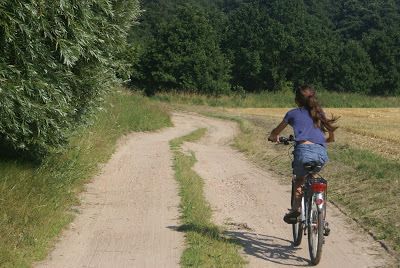 “Would you look at them,” she says, pointing to our children jumping together on a trampoline. They’re gangly kids at an awkward age, too tall for their motor skills. They’re bouncing wildly and acting silly, pretending not to be afraid. Karen speaks in a dialect I don’t always understand, but her face tells me everything plainly. We watch a moment longer before she goes back to the counter to arrange pastry on a baking sheet.
“Would you look at them,” she says, pointing to our children jumping together on a trampoline. They’re gangly kids at an awkward age, too tall for their motor skills. They’re bouncing wildly and acting silly, pretending not to be afraid. Karen speaks in a dialect I don’t always understand, but her face tells me everything plainly. We watch a moment longer before she goes back to the counter to arrange pastry on a baking sheet. “What can I do?” I ask and am handed an electric mixer with brief instructions to mix mascarpone with quark and whipping cream. The other women decide to pick sour cherries in the yard so only two of us are left in the kitchen.
“Your hair is still wet,” I say to Karen, who smiles apologetically.
“We just got back. It was a quick swim.”
“We would have gone too,” I nod, “but we didn’t have our suits.”
“Oh, neither did we.”
I laugh and try to imagine myself swimming naked in public in front of friends and neighbours. Would I do it too, if I lived over here? I doubt I would be the exception. I turn on the mixer recalling last Sunday when I was introduced to Martin at his parents’ house, at the table where he ate his childhood meals. He seemed astonished to meet someone new, a woman from Canada whose father knew his mother when she was young. After coffee, he drove us in his black Mercedes to a thirteenth century church to view an art exhibit.
Dinner is served outside on a table covered with a blue damask cloth. While we feast, the light around us dims. The sky pales then turns purple then midnight blue. Beyond the yard is an expansive meadow, an hypnotic space of wild beauty over which the cormorants fly. After we finish, Karen gets up to light a cigarette while her son Max disappears. I pay no attention until minutes later I hear a startling sound, a single note of music, coming from above. It’s Max on the deck, a metal stand in front of him, a gleaming clarinet in his hand. He begins to play, and I think of conversations I overheard as a child about my father’s family. They couldn’t leave, they couldn’t talk freely, they couldn’t buy a car. In 1981, for the first time, my brother visited our uncle Ernst at his apartment in East Berlin. I saw a photograph of two of my cousins, little girls then, climbing on the shoulders of my 20-year-old brother, tall and tanned and muscular. They look happy, I thought and was surprised. As the air fills up with Max’s music, I sink in my chair and let the notes settle over me like a warm blanket.
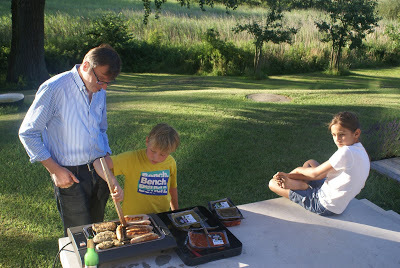 We move inside when it gets too dark to see and settle on leather couches. While my daughter stretches out and falls asleep, Ernst passes around a box of chocolates. There are two generations next to me who lived through the fall of communism.
We move inside when it gets too dark to see and settle on leather couches. While my daughter stretches out and falls asleep, Ernst passes around a box of chocolates. There are two generations next to me who lived through the fall of communism. “How much has it changed?” I ask when everyone seems relaxed.
Martin’s father looks at me but doesn’t answer. “Not much,” he then says while Karen says “A lot”. We all laugh awkwardly.
“There used to be nothing in the shops,” Karen explains. “You would go to buy eggs and there weren’t any.”
“But we didn’t live much differently,” Martin’s father says. Indeed, they still live in the house where Martin was born, have the same garden, the same friends, the same interests.
“But you have a business now,” I say. In 1991, Martin’s father left his government job to sell machinery to farmers on the island. Now he and Martin are co-CEOs of a company that supplies steel and other building materials, designs, and installations to companies all over the country.
“Yes. He works very long hours now,” Martin’s mother says. A guilty smile spreads across Martin’s father’s face as he tilts his head to look at his wife.
We talk some more and Karen asks: “What is your house like? Is it very big?”
It’s a little bigger than the house we’re sitting in, but not ‘very big’ by North American standards. “Big enough,” is what I tell her.
Martin smiles at me. “That’s a good answer,” he says.
We leave around midnight when Martin’s mother offers us a ride home. The whole way we don’t see another car and the darkness induces old dreams: if my father had never left Germany, who would I be now? Would I be living on Rügen, near Martin and Karen, among the wheat and the wildflowers? It’s been too quick, the way I’ve become accustomed to life on this pretty, strange island. I close my eyes and hear a clarinet’s note, clear and crisp in the cool night air.
_____________________________________________
Pamela Hensley is a graduate of the University of Western Ontario and the Humber School for Writers. Recently, her fiction appeared in The Dalhousie Review and she received an Honourable Mention in the Hamilton Short Works Prize. She lives in Ancaster, Ontario where she splits her time between writing and managing a consulting company.
Published on August 31, 2015 06:30
August 27, 2015
Feathered Nights by Sofia Lavista
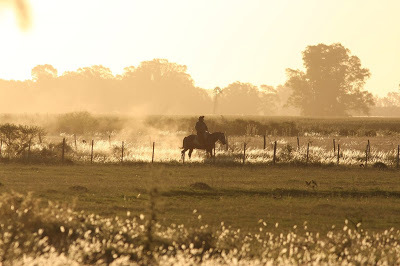
This must be the end of civilisation. The Argentinian pampas and clear sky stretch out to infinity. We are in the north-eastern province of Entre Ríos, which, as its name states, is sandwiched between two rivers: the Parana and the Uruguay. Until the late seventies, it was an isolated island of gauchos herding cattle. Still today, we can hear their whistling and the stomping of the hooves of their obedient cattle.
Just one hour north from Buenos Aires we reach the first bridge that crosses the longest river in South American after the Amazon: the Paraná, which gets its name from the original Tupi language para rehe onáva, meaning ‘as big as the sea’. Ahead, our road bisects the endless wetlands, teeming with water birds. The scenery and the local chamamé folk music playing on the radio mesmerize us. Suddenly, the aroma of firewood and homemade bread drifts through the open windows. We have reached Gualeguay, with its friendly welcome sign: Capital de la Cordialidad. We later learn that the entrance to Gualeguay is deliberately unobtrusive to dissuade tourists, who then head towards the much larger town of Gualeguaychú.
We stop and ask a local paisano for directions.
‘Could you tell us the way to Gualeguaychú?’
‘If you want to see what’s showing on T.V. take that road to the left and follow the signs. Otherwise, welcome this way to experience the real carnival.’
We are hooked.
The enchanting song of birds thronging the savannah blends with the slow grind of bikes and the cheerful greetings of locals in the streets. In Gualeguay there is plenty of time for drinking mate, the original bitter infusion of Guaraníes that still nowadays everybody shares on all occasions. We reach our hotel situated at the wide central square that breeds beautiful gardens of native trees, just in front of San Antonio church. After checking in, the receptionist, Zulema persuades us to beat the typical February morning heat with a walk in the Parque Quintana along the Gualeguay — the river that gives its name to the town.
The city glows under the summer sun, like people’s bronzed skin. The smell of jasmine and homemade bread accompanies us all our way to the park. There’s a bakery on every second block, each one specialized in a certain type of bread. Definitely, Picasso has the best tortas negras — biscuit bread topped with brown sugar, while the salty croissants are best at La Fenix. Reaching the park, we welcome the refreshing breeze in the eucalyptus grove and thank Zulema for her foresight in giving us insect repellent. We enjoy the light-hearted chatter of the parrots. Later we learn that they are considered a plague, since their nests are so high up in the eucalyptus trees that they don’t have any predators.
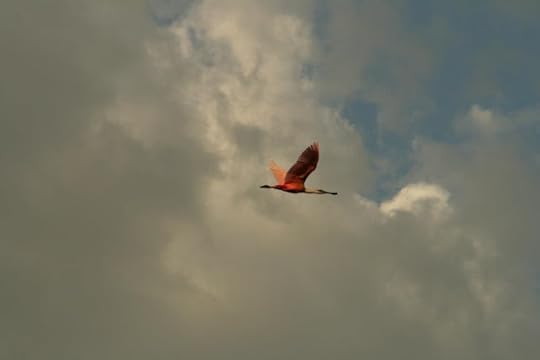 The park is equipped with benches and dining tables and several barbecue spots, where families are grilling their asados. We continue our stroll along the trees to finally reach the widest part of the river. A white sandy beach stretches out in front of us. The few locals sunbathing, drinking mateor canoeing do not seem to notice us. The water is cool and pale reddish-brown from the silt dragged all the way down from its source in the heart of Brazil, which also makes the bottom pleasantly sandy. We quickly improvise a picnic by the beach.
The park is equipped with benches and dining tables and several barbecue spots, where families are grilling their asados. We continue our stroll along the trees to finally reach the widest part of the river. A white sandy beach stretches out in front of us. The few locals sunbathing, drinking mateor canoeing do not seem to notice us. The water is cool and pale reddish-brown from the silt dragged all the way down from its source in the heart of Brazil, which also makes the bottom pleasantly sandy. We quickly improvise a picnic by the beach. Two local young men are amused by our English and approach us using every bit of our language they have learned at school.
‘Hello, my name is Alcides’, one says. He has a complete set for mate made out of braided raw leather. He indicates his friend, whose cheerful black eyes smile at us. ‘And this is Luciano.’
Half an hour later we all share a boat towards Puerto Ruiz, which was once an important commercial harbour for salted meat and other products formerly produced in Entre Ríos and transported by ship to Buenos Aires. We try to catch some dorado, the local speciality, with no luck. Our boat tour leaves us sunburned and tired enough for a slow early dinner and a good rest. After all, we just arrived this morning.
It is two hours till dusk so after a refreshing shower we decide to take dinner on the terrace. Gradually, a sound like a herd of horses’ hooves approaches, waking up the city. Suddenly, hundreds of people appear from nowhere, surround us, and we walk all together towards the source of the drumbeat. The music is addictive; the carnival has just started.
Someone throws foam on my face and I momentarily lose my vision. It has a sweet smell though, and feels smooth and warm. I can’t see my friends. I’m now sitting with soon-to-be new friends who offer me foam to play with. I am cheering for Si Si, the first of the local carnival parades on show tonight. The music fills my entire being as the orchestra approaches. The drum band opens the spectacular dance procession. After ten minutes, I already know the lyrics of their song and the basic steps. Glittery bodies topped with headdresses made of colourful feathers twist and pulsate at inhuman speed. Si Si keeps us haunted. My heart beats in time to the drums in an endless crescendo. Suddenly they stop and the trumpets blare: Gualeguay explodes.
The carnival continues non-stop for two hours. Gradually, it comes to an end. I eventually find my friends and exhausted, we stroll back to the hotel, exchanging our surreal experiences.
Alcides and Luciano pull up beside us in a van.
‘Come on up, we have mate and fresh croissants from La Fenix. We are heading to the beach.’
The sun rises bright behind the savannah, reflecting in the orange water. The first day of our long weekend seems to extend beyond the vast horizon, like the Argentinean sky. A flock of roseate spoonbills passes by flying above us on their morning peregrination to fresh water lagoons. They will come back tonight spangling the firmament with their colourful feathers, when Gualeguay wakes up again.
_________________________________________________
Sofía Lavista is an Argentinean biologist living in Germany. She has lived in four countries over three continents and is happiest visiting family and friends in her home town, Gualeguay. She combines science with writing poetry and dancing.
Published on August 27, 2015 06:30
August 24, 2015
On a Terrace in Peru by Stacey Venzel
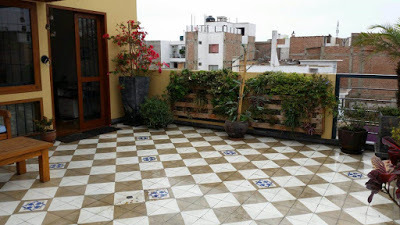 Mistakes abound when you’re frolicking in a foreign country. Language barriers, wrong turns and cultural faux pas are common threads between travelers. I once asked a waiter at a restaurant in Latin America if I should “sentirme” instead of “sentarme,” the difference between “feel myself” and “seat myself.” In Portugal, I took a path less traveled expecting to find solitude in the Algarve; instead, I encountered a colony of wrinkly, sunbaked skin in the form of elderly nudists—my first nude beach experience. I thought “Boxing Day” in the Bahamas referred to celebrating the sport of boxing… It does not.
Mistakes abound when you’re frolicking in a foreign country. Language barriers, wrong turns and cultural faux pas are common threads between travelers. I once asked a waiter at a restaurant in Latin America if I should “sentirme” instead of “sentarme,” the difference between “feel myself” and “seat myself.” In Portugal, I took a path less traveled expecting to find solitude in the Algarve; instead, I encountered a colony of wrinkly, sunbaked skin in the form of elderly nudists—my first nude beach experience. I thought “Boxing Day” in the Bahamas referred to celebrating the sport of boxing… It does not.But perhaps one of my favorite oops-a-daisy incidents to date is one that began like so many others—with a combination of pure stupidity and bad luck.
I booked a six-week trip to Peru on a whim, planning to start off visiting my sister in Lima. In the middle of my Peruvian adventure, my sister and her husband returned to the US for their own vacation. Prior to their departure, they kindly lent me a key to their apartment so I could let myself back in when my nomadic wanderings around the south of Peru came to an end.
I returned late in the night to their apartment four days before they were due back. When I woke early the next morning, clean clothes were first on my mind. I had hiked and slept in the same clothes for more than two weeks, and a sour smell was beginning to emanate from the cotton fibers on my sweatshirt. I threw on a running shirt and floral pattern skirt that had been left behind during my gallivanting. Sure, I didn’t match and yes it was chilly outside but I wasn’t planning on walking the streets anytime soon.
When I heard the ding! of the washer, I piled the clothes into a basket and tromped up to the third floor to hang my clothes outside. I found the key to the terrace on a side table, turned it in the lock, threw open the door and stepped onto the tile to place the basket on a table. Not more than two seconds later, I heard a loud thud.
“Nooooo,” I whined. That thud seemed to say it all, a noise punctuating bad news, confirming the unknown. I checked the handle just to be sure. Locked.
I frantically meandered around furniture and potted plants, checking the windows.
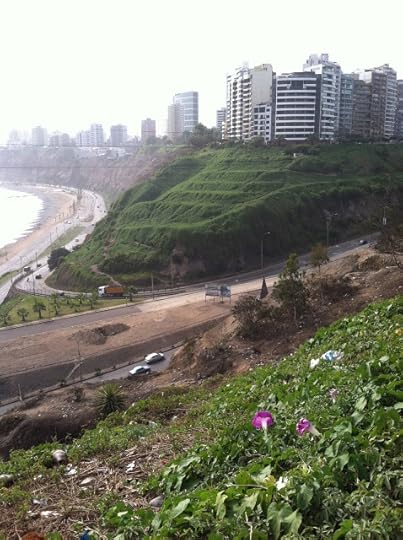 “Yes!” I nearly screamed. They were open. But homeowners in Lima obsess over security, even three floors high. I yanked repeatedly on the bars covering the glass, knowing full well it was a futile effort. Better yet, I could see my phone on the counter inside, mocking me, safeguarding the contact number for the housekeeper who had a spare key. She had cleaned the house in preparation for my arrival, a day earlier than her usual cleaning day—Tuesday. The day I locked myself out on a third story terrace in Peru.
“Yes!” I nearly screamed. They were open. But homeowners in Lima obsess over security, even three floors high. I yanked repeatedly on the bars covering the glass, knowing full well it was a futile effort. Better yet, I could see my phone on the counter inside, mocking me, safeguarding the contact number for the housekeeper who had a spare key. She had cleaned the house in preparation for my arrival, a day earlier than her usual cleaning day—Tuesday. The day I locked myself out on a third story terrace in Peru.I began rummaging in hanging ferns, lifting up clay pots, doormats and seat cushions in search of a hidden key. Defeat pulling in the reins, I did the one last thing I could think of.
“Cesar!” I whispered, leaning over the railing in the direction of the neighbor’s apartment three houses down. “Cesar!” I repeated to a man I’d met only twice before.
His face appeared in an open window.
“I locked myself out. I don’t have my phone. Can you call my sister to get the number for the housekeeper?”
He scurried onto the street and stared up at me as he tried to reach my sister and her husband on Whatsapp. After 30 minutes of texting and attempted phone calls, I tried to explain to him that they only receive messages when they are connected to Wifi, so they must be on the road. He didn’t quite seem to grasp the concept and continued trying to call them.
Exchanging the skirt for a pair of my clean, damp shorts, I Spider-man climbed atop the roof and surveyed my surroundings. There was no plausible re-entry. Cesar decided to see for himself. He used his homemade ladder to step onto the roof of the neighbor’s one story house. From there, he climbed up the ladder onto the terrace.
He tapped his lips in thought, then suddenly handed me his phone. “I have to go work,” he said. “This is my extra phone. Keep it in case they call.”
He crawled back down, leaving me cold, frustrated, hungry and helpless. I contemplated climbing down but then realized I didn’t really have anywhere to go. So I waited, slipper-clad and looking like a stranded Sporty Spice in the Peruvian winter.
Cesar said he would be gone 30 minutes. I’ve learned timing is grossly underestimated in South America. An hour-and-a-half later, he was climbing back up the ladder.
“This is for you,” he said, handing me a bag with a banana and piece of bread. In a country where my favorite animal is a delicacy, he still remembered I was vegan. And though he couldn’t quite fathom how I continue to live and breathe and enjoy eating without meat in my diet, he was kind enough to think of my growling stomach.
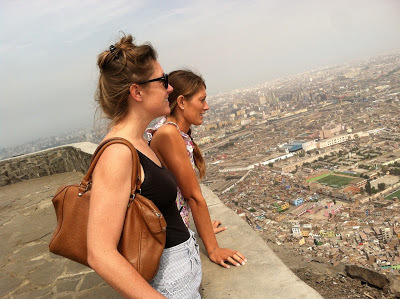 I told him I had not heard from my sister. I asked if he could give me the number to a locksmith, trying my best to explain “a person who unlocks doors” in Spanish. Then I noticed he was busily unloading tools from a zippered pack around his waist. He tied a piece of string to a hook and wedged it inside the door with the help of pliers. I commented that this didn’t look like his first rodeo. He chuckled but didn’t reply.
I told him I had not heard from my sister. I asked if he could give me the number to a locksmith, trying my best to explain “a person who unlocks doors” in Spanish. Then I noticed he was busily unloading tools from a zippered pack around his waist. He tied a piece of string to a hook and wedged it inside the door with the help of pliers. I commented that this didn’t look like his first rodeo. He chuckled but didn’t reply.In the middle of trying to loop the hook around the handle, my sister’s husband called, gave me the number to the housekeeper and wished us good luck. I inked the phone number on the cement wall with the juice from a leaf. I was ready to dial, but Cesar insisted on continuing with his invention. God bless Latinos and their persistent nature. Though a clever method, the handle was too heavy for the contraption and, ultimately, the string broke.
Four hours had passed. Grateful as I was for Cesar’s attempted break-in, I wanted desperately to get back inside, so I punched in the number for the housekeeper. She was more than willing to bring over the spare but was a bit of a drive away. Cesar returned to his home and told me to alert him when I was free.
I spent five hours of my trip to Peru stuck on a terrace. When the housekeeper unlocked the door, I walked to the neighbor’s to report the update. I rang the wrong doorbell.
“Hola?” a woman’s voice said through the intercom. I mistook her for Cesar’s wife.
“Estoy libre!” I shouted excitedly. Literally, that translates to, “I’m free.” I later learned from my sister that, out of context, I basically said “I’m a whore” to a stranger.
_____________________________________________
Zoologist, blogger and self-proclaimed comedian, Stacey Venzel has rescued sea turtles, bunked with a tribe in the Amazon, built a school in Brazil and performed various literal interpretations to pop songs on-stage. She grew up in Ohio and currently calls Long Island, Bahamas home base.
Published on August 24, 2015 06:30



